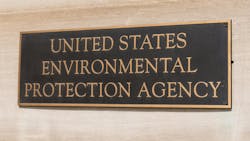Hard NOx news: EPA '27 rule to stay in place
In August, a group of 52 trucking associations asked the EPA to delay implementation of its stringent “low-NOx rule” for heavy-duty trucks from 2027 to 2031. The rule requires OEMs make engineering tweaks to their aftertreatment systems to drive NOx emissions down to 0.035 g/hp-hr., and that in turn will increase the cost of new trucks. With tariffs and a prolonged freight recession, the American Trucking Associations believed an extension is in order.
“As finalized, the heavy-duty NOx rule imposes substantial compliance costs and operational burdens at a time when the trucking industry is already contending with historically difficult market conditions," the ATA wrote to the EPA.
This week, the EPA announced the 2027 NOx rule is going ahead as planned.
“EPA reached out to various stakeholders, including ATA, the week of November 10 to share the status of the rule’s reevaluation,” said Patrick Kelly, vice president of energy and environmental affairs at ATA. “EPA staff shared that the Agency is moving forward to develop a proposal to be published next spring, but reconsideration of the 2027 NOx standard will be outside the proposal’s scope.”
However, the agency has signaled interest in potentially revising certain aspects of its broader 2027 heavy-duty emissions standards, reigniting hope for fleets concerned about the rule’s projected impact on future truck prices.
The EPA Press Office issued the following statement to Fleet Maintenance:
“EPA is working on reevaluating the 2022 Heavy-Duty Engine and Vehicle NOx rule, and is planning to propose a rule in the spring of 2026. If finalized, the action will make major changes to the program requirements while maintaining the Model Year 2027 start of the standards, which can significantly reduce the cost of new heavy-duty vehicles, while still protecting human health and the environment, and avoiding regulatory distortions of the heavy-duty vehicle market.”
As expected, there are few specifics provided in that statement. But the trucking industry may still have reason to remain optimistic that some changes to the upcoming emissions standards could at least sting less. One area in particular is the extended warranty life provision.
“ATA expects that these provisions, along with other technical amendments, will be included in the forthcoming proposal,” Kelly said. The ATA believes useful life standards and certain technical changes could also be amended.
“While we are disappointed EPA does not plan to fulfill ATA’s request to delay implementation and reconsider the standard, we are encouraged that the Agency is proposing several adjustments that should help lower costs and ease implementation,” said Dale Bennett, president and CEO of the Virginia Trucking Association. “We support ATA as it works with EPA staff through the rulemaking development process to ensure that opportunities to further reduce cost are maximized in implementing the 2027 standards, which will benefit Virginia’s trucking fleet owners and operators.”
Could engine costs drop from original forecast?
Read more on emisisons regulations
As currently written, EPA said its Control of Air Pollution from New Motor Vehicles: Heavy-Duty Engine and Vehicle Standards will intensify CO2 emissions standards by 25% by 2032 for sleeper cabs, and 40% for day cabs. The new standards start phasing-in for day cabs in 2028, while sleeper cabs hit in 2030.
The big change, the low-NOx rule, is set to kick in right away in 2027. It mandates an 82.5% reduction in NOx emissions from 0.2 g/hp-hr to 0.035.
The other significant change in the 2027 heavy-duty emissions standards is an extension of the required warranty period from 100,000 miles (five years) to 450,000 miles (10 years), along with an extension of the useful life limit from 435,000 miles to 650,000. Manufacturers are also required to ensure that engines and emissions control systems continue working properly throughout their useful life.
As ATA’s Kelly alluded to earlier, warranty/useful life is an area EPA appears willing to reevaluate. And according to Brian Antonellis, senior vice president of fleet operations at Fleet Advantage, it’s an area that could provide significant financial relief for MY2027 truck buyers.
“EPA 2027 hasn’t been pushed out, so engine manufacturers have had to prepare for it,” Antonellis said on the Fleet Lead podcast. “Almost every OEM already has an approved 2027 truck. So I think the cost increase for the hardware and software will still be there in 2027, which will probably be in the range of $12,000 to $15,000. But then there’s another $12,000 to $15,000 for additional warranty. That’s why fleets are hoping that at least some of that warranty portion gets some reprieve.”
Manufacturers are just looking for clarity as 2027 draws closer.
“Cummins is committed to delivering the innovative and efficient solutions our customers need to get their jobs done, and our ability to do so is influenced by regulations,” a Cummins spokesperson told Fleet Maintenance. “EPA’s direction on the 2027 low-NOx rule is an important step in advancing regulatory certainty, and we will continue to work toward our shared goal of fostering American competitiveness as the Agency finalizes the rule.”
All eyes on EPA’s spring 2026 proposal
For the time being, the trucking industry will have to patiently await EPA’s new rule proposal in spring 2026. With the ongoing freight recession also expected to linger into next year, it could be another long, nerve-racking winter for fleets.
“Our members can’t accept any more cost increases based on the impact of regulatory economics,” said Chris Spear, president and CEO of ATA. “It’s already too difficult to operate and employ our valued talent with added costs. It’s exceeding our members’ ability to remain successful each year. We welcome the improvements in safety and the environment, but these changes are not helpful after three years of a freight recession.”
Spear also suggested in the coming year that ATA may put pressure on lawmakers to repeal the 12% federal excise tax on new trucks.
"I think now we have a very good, grounded reason for asking for [the FET repeal]," he told media at the ATA's Management Conference and Exhibition in October. And the next package that moves through Congress, and very similar to lawsuit abuse [reform], we would be timing that through the end of next year."
It's too late to turn back the clock on Biden-era policies, but John Esparza, president and CEO of the Texas Trucking Association, laid down some grounded advice for how policies should be considered in the future:
“Texas trucking companies support meaningful environmental progress, but new regulations must be practical and achievable. Today’s trucks already reduce NOx emissions by 99%, and the technology required to meet the next EPA standard is not yet reliable or affordable at scale.
We need common sense reforms that align emissions timelines with infrastructure readiness, improve permitting for fueling and charging sites, and provide real-world reliability testing before mandates. Incentives—not penalties—could potentially harmonize national standards and help ensure progress without crippling the vast majority of small and mid-sized carriers who make up over 85% of the trucking industry in Texas.”
About the Author

Gregg Wartgow
Gregg Wartgow is a freelancer who Fleet Maintenance has relied upon for many years, writing about virtually any trucking topic. He lives in Brodhead, Wisconsin.
